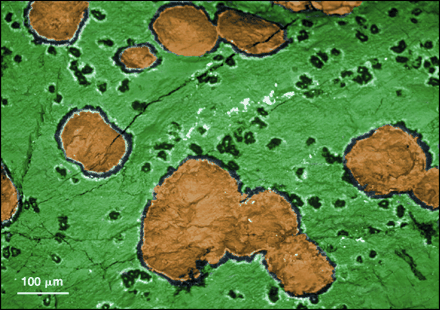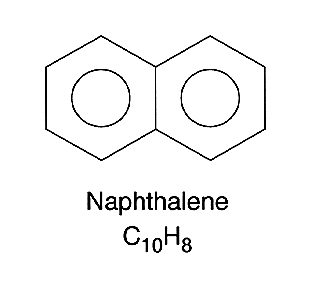Indications of Past Life on Mars
There are three specific pieces of evidence indicating past life on Mars. They are:
 1) Compositional Layering within the carbonates
1) Compositional Layering within the carbonates
Distinct compositional layering is seen in individual carbonate
globules. Layers like this are formed on Earth when the precipitation
of the mineral is aided by bacteria. These minerals are not
expected to have formed simultaneously under the same geological
conditions.
On the right is a false-color backscatter electron (BSE) image of a fractured surface of a chip from ALH84001 meteorite showing distribution of the carbonate globules. Orthopyroxene is green and the carbonate globules are orange. Surrounding the Mg-carbonate are a black rim (magnesite) and a white, Fe-rich rim.
2) Presence of Polycyclic Aromatic Hydrocarbons (PAHs)
 What are PAHs? Aromatic Hydrocarbons contain a flat ring of
carbon atoms, usually six arranged in a hexagon. Polycyclic
means that the molecule contains more than one ``aromatic'' rings,
such as the Naphthalene molecule here. These organic compounds
are easily formed by heating almost any organic or carbon-rich
material, and specifically from the decomposition of bacteria.
What are PAHs? Aromatic Hydrocarbons contain a flat ring of
carbon atoms, usually six arranged in a hexagon. Polycyclic
means that the molecule contains more than one ``aromatic'' rings,
such as the Naphthalene molecule here. These organic compounds
are easily formed by heating almost any organic or carbon-rich
material, and specifically from the decomposition of bacteria.
PAHs, however, ARE abundant in normal asteroid belt meteorites! However, the PAHs found (and there are MANY kinds), were quite different than those found in any other meteorite, and in fact are most closely matched to those found on Earth, originating from the decomposition of bacteria.